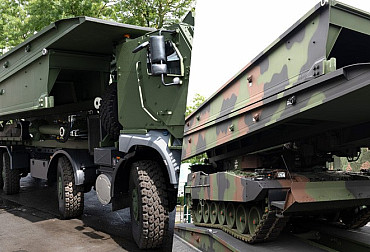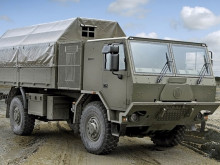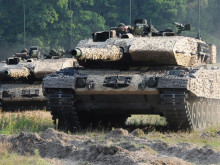Soldiers of the 73rd Tank Battalion get acquainted with the Leopard 2 A4 tank (VR 360° video)
One of the basic tasks of the 73rd Tank Battalion in Přáslavice is currently the transition from the so-called eastern to the western tank platform in the form of the Leopard 2 A4 armoured tank. It is not only about the expansion of the existing three-man crew (commander, driver, gunner) of the T-72M4 CZ tank to a four-man crew, i.e. supplemented with loaders, but it is a completely different way of operating the Leopard tank. Our soldiers have been getting acquainted with the first delivered Leopard 2 tank in A4 version since the beginning of the year, when they have been gradually getting to know all its features and advantages.
Video: Reportage - Soldiers of the 73rd Tank Battalion gradually get acquainted with the Leopard 2 A4 tank / CZ DEFENCE
In the first half of this year, Germany offered 14 Leopard 2 A4 tanks and one recovery tank on the same platform to the Czech Republic as a gift to countries that have provided their military equipment to the fighting Ukraine. The Minister of Defence then announced on 18 May 2022 that she and the German Minister of Defence Christine Lambrecht had agreed on the above-mentioned donation and the first Leopard 2 A4 tank would be taken over by our army at the end of 2022. The remaining 13 tanks will be delivered to the Czech Army later this year, and the ARV 3 Büffel recovery vehicle should be ready by mid-2024. In addition to the machines themselves, the Czech Army will also receive spare parts, ammunition and three years of service support, including training for soldiers. According to earlier reports, the price of the donation is CZK 3.85 billion.
Let's take a closer look at the Leopard 2 tank. It is the main battle tank of the German army continuously developed by the German company Krauss-Maffei Wegmann (KMW) from the 1970s to the present. Leopard 2 tanks are the only modern main battle tanks in production in Western Europe today. Over 3,500 of them have been produced to date and are in service in 19 countries. Just to illustrate, for example, the American M1 Abrams tanks serve in 7 countries, the British Challenger 2 tanks and the French Leclerc machines serve in 2 countries. The first version of the Leopard 2 tank entered service in 1979, followed by the continuous development of the A1 to A7 versions. The A4 version of the Leopard 2 tank with its perpendicular turret armour, together with the A5 and A6 versions, are the most widely used today.
 Picture: Leopard 2 A4 in the service of the Czech Armed Forces | Jan Juřica / CZ DEFENCE
Picture: Leopard 2 A4 in the service of the Czech Armed Forces | Jan Juřica / CZ DEFENCE
And what are the main differences between the T-72M4 CZ tank currently used by our army and the Leopard 2 A4 tank? The main difference is in the loading system. While in the T-72M4 CZ tank, which is operated by a crew of 3, namely the tank commander, driver and gunner, the cannon is loaded using a charging machine, the Leopard's crew includes an extra loader, which is able to load the first three rounds faster than the autoloader. In contrast, the advantage of the T-72M4 CZ tank's autoloader is its sustained rate of reload throughout the conduct of fire. A major disadvantage of the T-72M4 CZ is the possibility of failure of the automatic charging machine, which entails a possible drastic reduction in the rate of fire from seven rounds per minute to one round per two minutes. Also, the ammunition stowage in the T-72M4 CZ tank is not optimal and in case of a tank hit there is a high risk that the machine will explode from the inside due to ammunition hit, killing the entire crew.
Video: Czech Army - Shooting from Leopard 2 A4 tank (VR 360° video) - to rotate the camera in the desired direction, use the arrows in the upper left corner of the screen or press and hold the left mouse button and then move the mouse in the desired direction. Use the "+" and "-" keys to zoom the image) / CZ DEFENCE
The advantages of the German Leopard 2 tank are also confirmed by the Rheinmetall representative Otmar Schultheis, Technical Project Manager: "The acquisition of the Leopard 2 tank gives the Czech Republic access to new technologies, different from those of the T-72M4 CZ. In addition, better interoperability is guaranteed, including the corresponding upgrade potential. The experience gained with the Leopard 2 A4 tank is a good basis for possible decisions on the introduction of a future tank for the Czech Army, where the introduction of this type of tank is the first step towards increasing the combat effectiveness of the Czech Army's armoured forces."
In terms of firepower, mobility and protection, the Leopard 2 tank is one of the best prepared tanks of the NATO armed forces. The differences between the Leopard 2 A4 and T-72M4 CZ tanks are based on different Cold War doctrines, when NATO armies tried to compensate for limited mass production capabilities and human resources by producing high-quality tanks with better electronics and more comfortable conditions for the crew. The Leopard 2 A4 differs from the Soviet T-72 tank by more precise stabilisation of the tank gun in both planes, resulting in a higher probability of hitting the target with the first shot. Although heavier, the Leopard 2 A4 has a greater top speed and acceleration than the T-72 tank due to its 1,500 horsepower engine. Compared to the T-72M4 CZ tank, the Leopard 2 is heavier. According to Otmar Schultheis, the higher weight of the Leopard 2 has several advantages compared to the T-72M4 CZ, but also one handicap. Thanks to its longer chassis, the Leopard 2 is able to operate in difficult terrain with trenches that would be impassable for the T-72 tank. On the other hand, due to its higher weight, the Leopard 2 cannot cross certain bridges.
 Picture: Leopard 2 A4 in the service of the Czech Armed Forces | Jan Juřica / CZ DEFENCE
Picture: Leopard 2 A4 in the service of the Czech Armed Forces | Jan Juřica / CZ DEFENCE
Czech soldiers have been preparing to take delivery of the Leopard 2 A4 tank since last year, as revealed by Maj. Martin Vávra, deputy commander of the 73rd Tank Battalion. "We started the training last year. In the first part, we sent the first eight drivers for training in driving Leopard tanks. This was conducted in Germany under the guidance of specialists from the Bundeswehr. The second part was the theoretical part combined with training on simulators for tank crews. The training took place for four weeks in Austria. At the beginning of the year, the final training and subsequent final firing for these crews took place in our country. At the moment we have two fully trained crews. The complete training of the remaining crews will take place during the year and should be completed in October," says Maj. Vávra.
The deputy commander of the 73rd Tank Battalion also praised the quality of our soldiers in driver training. Bundeswehr representatives praised the approach to training and the willingness to acquire new skills and tasks. Captain Nicolai Grüneberg of the 93rd Battalion confirmed this to our magazine. Tank Battalion in Munster, where the training of our soldiers took place. "The Czech tank drivers attended a tank driving school in Munster, Germany, where they completed a regular and a complete driving course in English. The soldiers soon realised the comfortable driving conditions and easy handling of the Leopard 2 compared to the T-72M4 CZ. The tank crew also quickly got used to having 4 members in the tank."
According to Major Vávra, the transition to the Leopards was not a problem for our soldiers, including the new number of crew members for our tankers. We asked how do the soldiers rate their first experience with the Leopard 2 A4 tank? "Very positive. They are really enthusiastic and I feel that they see the transition as a step forward and another element of motivation to continue with our battalion," says Maj. Vávra.
During the recent live firing of a Leopard 2 A4 tank in Přáslavice, we also had the opportunity to talk to some of the crew members. Specifically, we spoke with Corporal Stanislav Ilcik, who serves as the tank driver, and Sergeant Miroslav Rýdel, who serves as the gunner. "For the gunner, it is definitely a big leap forward in terms of both weapon stabilisation and accuracy. It's definitely backed up by German precision. That is something that is very noticeable and it is only good for us to be able to train on this type of equipment and to be able to work with it. The tank is a bit heavier, but you don't notice that at all when you drive it. The performance is sufficient for manoeuvres, as well as for driving on the road and off-road," the soldiers evaluate the German tank. Sgt. Miroslav Rýdl has also been trained as a loader, the 4th member of the crew, and we were naturally interested in the first experience with this new position. Then there is the actual handling of the ammunition when loading, when loading on the move, loading the machine gun that is connected to the gun and another machine gun that is actually an anti-aircraft gun. It has a lot of pitfalls, but we can handle it." Another important capability of the tank is the gunnery, which Sgt. Rydl said is accurate. "It's particularly the level of weapon stabilisation, if we're driving over very difficult terrain, where as a gunner I'm searching at 12x magnification, searching to a long distance without feeling that we're driving in difficult terrain. I can spot everything very well and despite the fact that we are travelling at high speed, we can shoot very accurately at that. So as far as I'm concerned as a shooter, it's a lot better for us," praises the German tank gunner.
 Picture: Shooting from Leopard 2 A4 tank | Jan Juřica / CZ DEFENCE
Picture: Shooting from Leopard 2 A4 tank | Jan Juřica / CZ DEFENCE
There are two MG 3 machine guns on the tank, one of which is an anti-aircraft gun and is operated by a loader. This machine gun is new to the crew. Until now, the crew has operated with the NSV anti-aircraft machine gun and the PKT tank machine gun. In the interview, both soldiers agree that there is a lot of space in the Leopard, despite the larger crew, especially in the area for the loader, who stands while working. Two types of ammunition are carried in the tank, with the fragmentation round weighing 29 kilograms. This means that the loader will take up to 6 quintals of ammunition when using about half of the total ammunition supply. Both soldiers also have positive views of the tank's protection. "As far as protection is concerned, first of all it is a defensive tank, so to speak. So the protection from the front is enormous. In addition, the armouring of the turret has been strengthened with further upgrades and the overall protection is many times greater," the soldiers said.
That being said, the 73rd such battalion should receive the remaining Leopard 2 A4 tanks by the end of this year. On this deputy commander of the 73rd tpr, Maj. Vávra adds. Next year we expect to receive a recovery tank. The training will be adapted to this. We are expecting three more courses for tank crews - the gunner, the loader and the commander. The courses will take place in our garrison under the direction of the German training team." The Leopard 2 A4 tanks will primarily be used to train soldiers of the 73rd Tank Battalion, including active reserves. They will ensure a smooth transition to the new type of main battle tank and its implementation into use in the Czech Army. Until then, the T-72M4 CZ tank will remain in the armament of the 73rd Tank Battalion.
 Picture: The Leopard 2 A4 tanks will primarily be used to train soldiers of the 73rd Tank Battalion, including active reserves. They will ensure a smooth transition to the new type of main battle tank and its implementation into use in the Czech Armed Forces. | Jan Zilvar | CZ DEFENCE
Picture: The Leopard 2 A4 tanks will primarily be used to train soldiers of the 73rd Tank Battalion, including active reserves. They will ensure a smooth transition to the new type of main battle tank and its implementation into use in the Czech Armed Forces. | Jan Zilvar | CZ DEFENCE
In connection with the acquisition of the new tanks, the Ministry of Defence announced last May that it would start negotiations on the purchase of up to 50 additional Leopard 2 tanks in the latest A7+ version. In December last year, as part of the review of the first year of the implementation of the Defence Decalogue, the Minister of Defence Jana Černochová, when asked about the acquisition of new Leopard 2 A7 tanks, said: 'Of course, the interest is still there. At the moment we are preparing a study to evaluate the technical specification, which will also determine the future course of action in building up the tank army. Of course, this option (A7, editor's note) is being offered, but the soldiers and we have to proceed in a completely transparent manner, so we cannot leave anyone out of the market, which is not very large. At the moment, we are still doing a project study so that we have an overview of the price ranges and what is actually on the market at the moment, because of course, also thanks to the war in Ukraine, new players are entering the market. We are not as big as the Republic of Poland to be able to afford to have three or four types of tanks here. But it is certainly worth considering perhaps expanding some of the acquisitions outside Europe to countries that also have something to offer. I'm talking specifically about Korea, because Poland has agreed on this particular purchase."





















